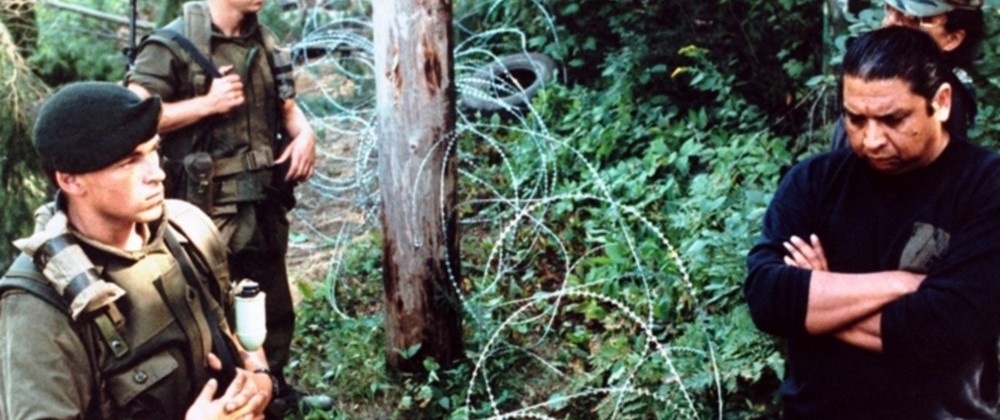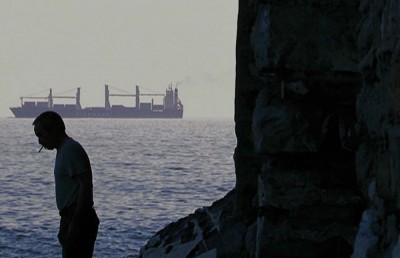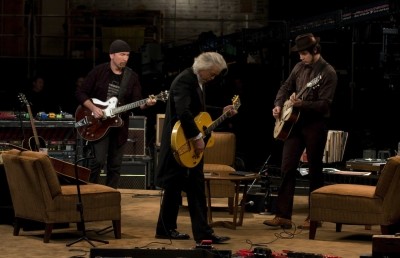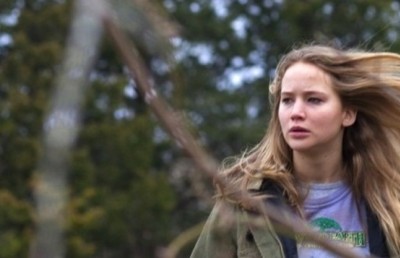(Re)covering Oka: Alanis Obomsawin’s Representation of the Crisis at Oka

In 1990, barricades were erected around the Kanehsatake Mohawk reserve a mere 25 miles from Montreal. The barricades were put up in order to prevent the development of condominiums and the expansion of nine more holes to the local golf course on reservation land, including development through the Mohawk’s sacred pines and cemetery. Abekani filmmaker Alanis Obomsawin was able to document the seventy-eight day standoff between the Mohawks, the Quebec National Police (SQ, Sûreté du Québec) and the Canadian army. Obomsawin, as a filmmaker working for the National Film Board of Canada, was allowed to cross the barricades and document the standoff from the perspective of the Mohawks involved in this historic land dispute. Obomsawin has made four documentaries dedicated to telling the story of the Mohawks of Kanawake involved in the 1990 crisis. The first installment Kanehsatake: 270 Years of Resistance (1993) focuses on the crisis as it unfolded in front of Obomsawin’s cameras. She followed this award winning feature documentary with three more films that explore and expand upon the crisis: My Name is Kanehtiisota (1995), Spudwrench: Kahnawake Man (1997) and Rocks at Whiskey Trench (2000). I will discuss these four films focusing on Obomsawin’s representation of the Mohawk men, women and children who were involved in the standoff and the aftermath of the crisis. Obomsawin’s ability to recover Mohawk history specific to Kanawake makes for an interesting case study in the Mohawk community’s marginalization, their long history of colonial oppression and on-going land disputes. Beyond the brutal history that has been the fight for Indian sovereignty, Obomsawin has focused on Mohawk identity and culture, as well as the problematic situation of the Mohawk people within Canada, Quebec and straddling the U.S./Canada border. Obomsawin has effectively presented a series of documentaries in which the Mohawk people themselves are afforded a voice—no longer silenced—to tell their story, that has been displaced, erased and negated by homogenous Canadian and Québécois history.
In his book about Obomsawin, Randolph Lewis identifies four threads running through Obomsawin’s body of work. Lewis posits that Obomsawin has 1) focused her lens towards challenging the formation of public memory and history, 2) on the place of Mohawk women in Kanehsatake, Kahnawake and Oka, 3) on the political and cultural resilience of the Mohawk people looking specifically at cultural creativity and daily life, 4) and finally to expose the systematic oppression and the entrenched racism in government policy (79-80). I found one thread to be conspicuously absent; the one thread that was not explained to my satisfaction was the role of and representation of the Warrior Society. Within all of Obomsawin’s four Oka films, Warrior Society is represented in such a way as to dispel many myths about the Mohawk people and their connection to Warrior Society. Spudwrench: Kahnawake Man lays bare the history of the Mohawk ironworkers who found steady employment doing hard labour, essentially building New York City until the mid 1970s. In this sense Obomsawin allows the men and women of Kanawake to explain in their own words what it means to be Mohawk. The many ironworkers who speak about their life’s work repeat words such as “risk,” “pride,” and “honor.” The men and women speak of the impact the long-distance work had on family and community life. Perhaps it is not surprising to hear the people themselves explain the way they were able to adapt the concept of family to their needs. The men explain that every Friday night they would take the six and a half hour drive from New York City up to Kahnawake in order to spend the weekends with their families, before driving back at the crack of dawn on Monday mornings, year after year. The resilience and adaptability of the Mohawk people as well as the importance of family and the role of the women are indeed threads that run through Obomsawin’s work.
Without delving into the convoluted history of Warrior Society, Obomsawin devotes her attention to the cultural life and traditions of the Kahnawake Mohawks. In this sense Obomsawin neither disentangles the Warrior Society and the mainstream media’s representation of the Warrior, nor conflates the Mohawk people with the Warrior Society. Amelia Kalant suggests that, “the dramatic impact of the warriors’ masks and camouflage clothing was a double-edge sword” (187). On the one hand, the image of the Warrior was attention grabbing. The Warrior image disrupted “the assumptions about Canadian fairness to ‘their Indians’ that many continued to hold” (Kalant, 187). Whereas, the Warrior image was easily aligned with what Canadians also wanted to believe about Indians, the Warrior problematically provided the Canadian government with a stereotype that was readily employed to render the entire crisis “illegitimate” (Kalant, 187). By employing this Warrior archetype, Indianness was aligned against modernity and away from Canadian, or Québécois, nationalism positing the Warrior as American. The problems of land disputes, and national belonging are fleshed out in Spudwrench: Kahnawake Man by way of the long history of the Mohawks working state side as ironworkers for several generations. The ironworkers, including Randy “Spudwrench” Horne tell their own story of their involvement building the Mercier Bridge that led to steady, but hard, work for a good portion of the twentieth century. Obomsawin traces the role of the ironworker and the impact of steady work for the Kanawake men and their families. The constant cross-border travel and work further confused Mohawk national belonging in the eyes of the media. During the crisis at Oka the media were allowed to spin the ironworkers into a militant American Indian faction completely divorced from the Mohawks of Kahnawake.
According to Brain Johansen, Warrior Society did not emerge in print until the 1989 gambling and smuggling disputes between the Mohawks of Akwsesasne and the State of New York. However, Jeff York and Loreen Pindera assert that after tense land disputes over the Seaway in 1968, Warrior Society evolved from the Singing Society that had developed in an effort to preserve Mohawk language and culture through traditional songs and drumming. Drumming, singing and circle dances are presented as thriving aspects of Kahnawake’s Mohawk community in Spudwrench: Kanawake Man. York and Pindera explain that many of the founders of the Singing Society became founders of the Mohawk Warrior Society, the term “warrior society” had never been used in Iroquois history but there was a long history of secret societies, including medicine societies and mask (false face) societies, which kept tradition alive through ritual and ceremony (171). Warrior Society combined these traditions, as it was the warrior’s role to embody the responsibility of defending their people (York and Pindera, 171). For example, Kalant explains how The Gazette, the English language daily newspaper in Montreal, reinforced the “hyper-masculinity of the Warrior’s abusive power” by feminizing the victimized community when it was noted that the Warrior guns happened to be the same type as that used by Marc Lepine of the 1989 Montreal Massacre at the École PolyTechnique (195).
In fact, Obomsawin shows there is little schism between the Mohawks of Kahnawake and the Warrior Society, without conflating both groups positioning them as violent, dangerous rebels. Rather, struggle and resistance has been the long suffered history of the Mohawk people since Columbus arrived centuries ago. Crisis at Oka was only one of many ongoing land disputes. I was surprised to learn about a series of barricades erected in years leading up to Oka in 1990, including the barricade across the Mercier Bridge one year before Oka, and another blockade across Chemin du Mille protesting the condominium and golf course development as early as March 1990 (Johansen, 136). Obomsawin alludes explicitly to the struggle of the Mohawk people in the title of Kanehsatake: 270 Years of Resistance. The title alone presents Oka as the boiling point amidst three centuries of land disputes. In fact, 1989 was a volatile year that sullied the Mohawk image in the public eye during a course of pro and anti-gambling and smuggling situations involving Warrior Society and the American government. This certainly had its effect on the spin that the Canadian media would take in representing the Warrior as Un-Indian, distinctly non-Canadian and certainly not Québécois. Paul Williams wrote for Senses of Cinema that “Obomsawin’s construction of a third space allows for a unique definition of identity, community, and home in a distinctly indigenous framework, allowing not only for a physical space but also a mindset for the indigenous identity to develop” (screen 1). Within this third space Obomsawin allows for daily life in Kahnawake to unfold along with all its daily interruptions. The traffic, pollution, the Mercier Bridge and the Seaway, along with the Canadian National Railway are thoroughly integrated into the life of Kahnawake. The Mercier Bridge carries over sixty thousand cars to and from Montreal’s suburbs daily. Using panning shots of Kahnawake’s skyline Obomsawin is able to open up a space of juxtaposition, from imposition of ever expanding industry that has encroached, or invaded, upon reserve land with the quiet community of the Mohawks who actively work to recover tradition, culture, language and family life. The opening and closing shots of Spudwrech: Kahnawake Man frame the small town, panning across the skyline eventually incorporating the Mercier Bridge and it’s traffic into the landscape. One startling effective shot in My Name is Kahentiisota frames the narrow space between two Kanawake homes capturing a barge as it passes along the seaway cutting across the landscape and blocking the view of the water. The women speak of the noise and pollution that has encroached upon Kanawake. One woman states that the Mercier Bridge is a structure that can be seen from any point in the town.
My Name is Kanehtiisota focuses attention on the Mohawks commitment to Mother Earth and Mohawk culture through Kanehtiisota’s story. In this short documentary Obomsawin trains her lens on the role of the women who were involved in the seventy eight day standoff, specifically focusing on Kanehtiisota’s role. Kanehtiisota is the mother of two children and a resident of Kanawake. She joined the Oka resistance four months into the standoff, bringing her four children with her across the barricades. Obomsawin has been quoted as saying “In our language there is no word for he or she” (Lewis, 70). In a similar sense there is no Mohawk word for Warrior. Like Spudwrench, Kanehtiisota’s story is woven into Kanehsatake: 270 Years of Resistance, Obomsawin expanded on these stories as a way to redress the incident and to flesh out the stories of the people directly involved. In doing so Obomsawin affords a voice to not only the Mohawk’s side of the story but disentangles entrenched gendered stereotypes revolving around Warrior Society, and the resistance at Oka. Obomsawin discredits the violent masculinist stereotype of the Warrior by making the issue a moot point. The women and the men repeat across all four films the importance of the land, and their duty to protect it. Furthermore, the Mohawk connection to the land and the past and future generations is another thread across these four films. One woman states, “Kahnawake, that’s the only thing we have left, we’ll never give it up.” Kanehtiisota, herself, explains the importance of the pines, where the golf course was due to expand through a series of voice-overs and using direct address.
In My Name is Kanehtiisota, Kanehtiisota herself states, “the pines, they are our grandfathers. We have to give thanks to the trees, they are not just standing in the way of a golf course.” She explains how Oka was representative of all Indian people who have witnessed land takeovers for centuries. She strongly asserts, “Now we resist.” Kanehtiisota begins her story by telling how there are no borders within the Mohawk region. This statement is of note, as the Oka crisis actually occurred on the south end of the Mercier Bridge in the area known as Kanehsatake and the town of Oka, whereas Kahnawake is situated on the North side of the bridge. Furthermore, the physical location and implications of the blockades are expanded upon in the documentary Rocks at Whiskey Trench that I will discuss further along. Johansen explains how the creation of Akwesasne, Mohawk reservation land that straddles the Quebec/Canada/U.S. border resulted in 3 Indian councils (Akwesasne, Kahnawake and Kanehsatake) vying for power over eight thousand people on 28,000 acres of heavily polluted land astride the Saint Lawrence (ix). Kanehtiisota tells of how the Mercier Bridge cut the Mohawk people off from the water and then when the Canadian National Railway was built it cut across Mohawk land imposing more boundaries. These encroachments of modernization have damaged and changed the wildlife and clear-cut straight across Mohawk trap lines. It is easy to understand in this sense why the Mohawk people of Kahnawake and Kanehsatake felt that the golf course expansion was the last straw in a long history of imposed boundaries framed as invasion. To compound the issue, the Oka municipality did not consult the band when approving the development and as a result, prior to the crisis, in the summer of 1989, thirteen hundred residents signed a petition to stop the development. The petition was ignored and plans proceeded (Johansen, 136-137).
The issue of the cemetery is expanded upon in Spudwrech, though Kanehtiisota also mentions the importance of the cemetery and how development would have meant digging up the cemetery. She explains the significance of a sacred resting place for the Mohawk people by saying that the ancestors cannot rest peacefully until they are protected from further invasion. In Spudwrench the importance is reframed in a poignant montage showing the photos and names of passed over Kahnawake ironworkers who rest in the Kanehsatake burial grounds amidst the pines. By putting names and faces to shots of graves the burial ground becomes less of an ideological problem and more of a material concern. Obomsawin does not set up the two different perspectives on the burial grounds in opposition. Rather she reveals how complex the issue is by allowing layers of meaning to surface in dialogue with each other. In no way does Obomsawin pursue one Mohawks perspective as more important or accurate. The significance of the burial grounds is yet another thread that weaves its way through Obomsawin’s four Oka films. The montage sequence in Spudwrench is edited over a folk song sung in Mohawk by a woman. The words of the song are not translated, allowing the issue of language to surface in a subtle but striking manner. Perhaps out of my own ignorance I was surprised to see, not some unmarked burial ground, but a cemetery amidst the pines, with graves marked by iron bars in the form of a cross. The names and dates on the each memorial were recognizable and tied to the people of Kanawake who have spoken about their history as ironworkers. Obomsawin’s footage of the burial ground reframes the problem by countering such presumptions about what a sacred burial ground is.
The issue of language is present across all four films, in My Name is Kanehtiisota language is addressed head on; an always already touchy area given Obomsawin’s place within Québécois film history. The issue of language is present in many forms, while My Name is Kanehtiisota focuses on Kanehtiisota’s fight to have her Mohawk name recognized by a Canadian court of law. Language is framed as explicitly tied to the plight of Indian sovereignty. After a peaceful walk out was arranged on the 26th of September, Kanehtiisota was arrested along with 19 other Mohawk women. She however was held four days longer because she refused to give her “Canadian” name. The underlying issue being the fact that her Mohawk name would not be recognized in a Canadian court of law. Of the Mohawks arrested Kanehtiisota was one of 19 women, 30 men and 7 children. The children and women were separated from the men, while the children who had relatives at hand were released into their custody. Kanehtiisota describes in voice over, the chaos and fear she had for her children until they were reunited on the women’s bus. The men and women arrested were transported to a Canadian army base south of Montreal where they were charged and detained over night. The children, including Kanehtiisota’s two boys, were released to family. Kanehtiisota on the other hand was held for four days longer than the other women on account of her insistence on using her Mohawk name. On October 2nd, Kanehtiisota is released after her lawyer produces her birth certificate to the St. Jerome’s court judge. She was detained for six full days. On October 5th the men were released from custody and returned to Kanawake; all this for a name in English or French but not in Mohawk.
It may seem irresponsible for children to be placed at the center of a volatile situation however, Kanehtiisota strongly affirms that for the Kanawake mothers, it was important that their children not be hidden from the legacy of violence that has plagued the Mohawk people. Many of the women in My Name is Kanehtiisota describe the Mohawks belief in maintaining a concern for the future generations. Kanehtiisota holds steadfast to the notion that “the young ones see and become stronger.” As a result many of the children who grew up in the aftermath—and the few who remember—are now referred to as “Oka Babies.” This is so that they are always reminded of the struggle of their people and to reaffirm the strength and solidarity of the Mohawks. In both My Name is Kanehtiisota and Rocks at Whiskey Trench, Obomsawin allows the children to speak for themselves, often expressing through tears the fear they faced on August 28th during the supposed evacuation. As Lewis purports Obomsawin “listens to the subject and allows even the most vulnerable child to be heard as a distinct individual” (87). This is reaffirmed by in Spudwrench with close attention to the daily cultural resilience of the Mohawks of Kahnawake through sweat lodges, healing circles, drumming and circle dances. One man states that it is, “good to recall, wounds need to be cleansed deeply and profoundly.” The sentiment “we must continue but we cannot forget” is expressed by various Kahnawake residents across the four films.
The complacency of the Quebec SQ becomes a major focal point in Rocks at Whiskey Trench depicting the failure of the police to safely see a convoy of sixty some cars across the Mercier Bridge and through to the neighboring town of Châteauguay to Kahnawake. The incident on August 28th directs attention to the violent hatred of 500 angry residents on the South Shore of the Mercier Bridge. Kalant explains that racism similar to that exhibited at the Mercier Bridge could be found throughout Canada and was not particular to Quebec (188). Rocks at Whiskey Trench expands on the Oka crisis by interrogating the axis of racism and hatred between Quebec and the ROC (rest of Canada), making Canadian sympathy with the Mohawks a betrayal of sorts in the eyes of the Quebeçois pitted against the Mohawks. The Quebeçois also already occupying a multivalent position within Canada with a history of oppression and racism that parallels the complex situation of the Mohawk people, who happen to be situated not only under the jurisdiction of Quebec, but also straddling the U.S./Canada border. The failure of the Meech Lake Accord in 1989 was not the only catalyst that lit the fire of Oka. Beyond the encroachment of ongoing modernization, the crisis led to numerous checkpoints, and 10 roadblocks erected by the police and army, including two boats patrolling the Ottawa River in early July 1990. Later, on July 20th the police blockades actively prevented the protestors behind the barricades from receiving medical supplies, medical attention and food. This issue is central in Kanehsatake: 270 Years of Resistance and the other films. Obomsawin unapologetically presents the SQ and the Canadian army as gravely ill-equipped to handle the resistance. To compound the problem, the local French language radio enticed people to gather and riot. The convoy of vehicles carrying women, children and elders across the bridge and through Châteauguay where met on the North side by hundreds of angry protestors waiting to pelt rocks, bricks and boulders. The swat team failed to show up and the SQ were not equipped to handle a riot. The rain of rocks was more than salt in an open wound, after the convoy had been stopped on the bridge for a solid three hours while every car and person was searched. The angry mob not only pelted rocks at the convoy but shouted insults in French and English yelling, “savages.” Though many of the terrified evacuees could do little more than cover themselves with pillows crouched in the back seats one boy describes looking out the window to see the faces and allow them to see him. He explains, “Whoever was there would see me looking…see a strong face, being strong. I wouldn’t hide.
I agree with Lewis’ identification of four threads that run across Obomsawin’s work. However, I find that there are more than four threads and it seems Obomsawin has carefully woven the threads together. A strong rope is the combination of countless indispensable threads –not threads that are pulled apart. In this sense, her work is very much in line with the concept of collective coming together as One. Each film has threads that connect them beyond the scope of the 78 day stand off. The threads that run through Obomsawin’s Oka films do not single out issues or prioritize. Rather –like the threads that weave together– no one single thread is less or more important that another. The Circle Dance and Drumming sequence in Spudwrench underlines this concept. In one scene it is explained that the song that is being sung was composed of verses collected through travels across the country, by which the Mohawks reached out for solidarity from other bands and clans. As the song heightens, the circle dance becomes tighter, which is symbolic of indigenous solidarity and the coming together as One. Taking this concept into account, it is easy to consider Obomsawin’s four Oka films as one film expanding outward and simultaneously bringing all the elements, perspectives, people and history together, as One.
Bibliography
Johansen, Bruce E. Life and Death in Mohawk Country. Golden: North American Press, 1993.
Kalant, Amelia. National Identity and the Conflict at Oka: Native Belonging and Myths of Postcolonial Nationhood in Canada. NY: Routledge, 2004.
Lewis, Randolph. Alanis Obomsawin: The Vision of a Native Filmmaker. Lincoln: University of Nebraska Press, 2006.
Williams, Paul. “Alanis Obomsawin” on Senses of Cinema. Sept 2002.
York, Geoffrey and Loreen Pindera. People of the Pines: The Warriors and the Legacy of Oka. 2nd Editon. Boston: Little, Brown & Company, 1992.













